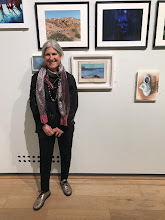 |
| pastel on board 54 x 34 cm, Category Four, October 10, 2018 |
After what felt like a busy week, making Pauline's book cover, going to London twice and having a friend (and her mother) who I haven't seen in 30 years visit, everything was a bit on top of me. To avoid feeling hysterical, or paralysed I started a weekly habit of thinking about what I need to do over the week and spent my first free evening making a book to put those lists in. Ah, the art of distraction!
After Charles' class, one of the things on my list was to read ( or probably re-read) a book on contemporary drawing my mother bought for me or our daughter.
Much of what Charles said or hinted at or maybe what I was thinking about as I went through his exercises is the focus of the book. I began taking notes…
Contemporary drawing:
Margaret Davidson, 2011
1. ‘What the surface is determines the nature of the mark. Furthermore, a focus on both the surface and the mark and the relationship between the two is one of the hallmarks of contemporary drawing, and one of the most fundamental abstract issues drawing artists deal with.’ p 10
2. ‘One distinguishing feature of contemporary drawing is the choice being made by some artists of the source of the mark-making. Some artists let natural forces produce, or help produce their drawing marks. Others look for cultural influences to map out or even control their mark-making. Many combine those two factors into a third realm of mark-making wherein they set up the parameters but cannot foresee the outcome… (these) contemporary choices add a significant layer of meaning to the drawings.’ P 10
3. ‘The relationship between space and surface is a key thing, as well as the artists’ intentions with illusion and reality.’ P 10
4. ‘Composition is a structure of one kind or another within which artists present their imagery and clarify their ideas.’ P. 10
5. Scale – 3 points of view:‘how the scale relates to the artist, how the scale relates to the mark (which has to be quite different, depending on the size of the drawing), and how the scale relates to the viewer of the art, upon whom the impact is, maybe, the greatest.’ P. 11
6. ‘the concept of materials (and tools)’ p. 11
7. ‘some artists today are crossing media boundaries, making drawings that are also sculptures… if you find that following the direction the art is taking you means going outside the boundaries, well do it. In the end, the boundaries don’t matter.’ P. 11
8. Intentionality: ‘must be learned, and then practiced on one’s own art, and when looking at other art.’ P. 11
So today when I began drawing, all of that was in my mind. I went through the usual stages of feeling overwhelmed, sick, disgusted and then slowly found my bearings. I think the image here is a little greyer than it is in the flesh.
At one point when I thought it was garish and all was lost, I looked at Matisse for answers. Seeing his riot of colour helped calm my nerves…
Below is my experiment using pigment mixed with pva and methyl cellulose in an altered book. I liked the freshness and it feels like the pigment will stick to the page!





















